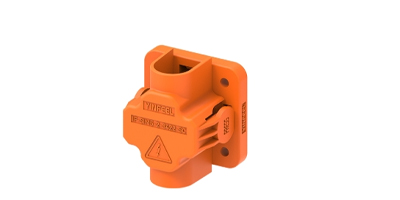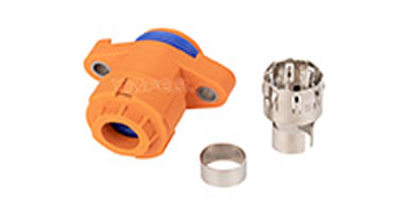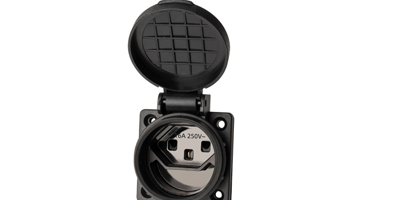The square shaped wall-through type terminal is widely used in many electrical installation fields. Its unique structural design enables it to effectively meet the needs of wall penetration cabling, electrical connection and protection. The following will analyze the key points of the structural design of the square shaped wall-through type terminal in depth.

Outer Shell Structure
Shape and Size Design
1.The square design gives it a regular shape, which is convenient for installation and positioning on the wall. The side length and thickness are carefully planned. The side length is determined according to the common electrical cabling requirements and the reserved space on the wall. For example, in general building electrical installations, the side length may be designed to range from 100 mm to 300 mm to accommodate the penetration and connection of different specifications of cables. The thickness takes into account the thickness of the wall and the layout space for the internal components, generally ranging from 50 mm to 150 mm, ensuring that sufficient accommodation space is provided for the internal electrical components without affecting the structural strength of the wall.
2.The corners are usually rounded, which not only increases the aesthetics of the outer shell but, more importantly, reduces the risk of personal injury or outer shell damage caused by collisions during installation and use. For example, in crowded places such as shopping malls and office buildings, the rounded corner design can effectively avoid sharp injuries when people accidentally collide.
Material Selection and Characteristics
1.Metal materials such as aluminum alloy or stainless steel are often used. The aluminum alloy material has the characteristics of light weight and good corrosion resistance. After the surface is oxidized, its corrosion resistance can be further improved, which is suitable for electrical installations in general indoor environments or slightly corrosive environments. Stainless steel has higher strength and stronger corrosion resistance. Especially in harsh environments such as industrial plants and sewage treatment plants where it is wet, acidic or alkaline, the square shaped wall-through type terminal with a stainless steel outer shell can operate stably for a long time and effectively protect the internal electrical components.
Internal Component Layout
Layout of Terminal Blocks
♦The connection methods of terminal blocks are diverse. The screw fastening type terminal block fixes the wire by tightening the screw, which has a firm and reliable connection and is suitable for high-current connections or occasions where high connection stability is required. The plug-in type terminal block is convenient for quick connection and wire replacement and is more suitable for application scenarios where the lines need to be adjusted frequently, such as the electrical cabling in temporary exhibition venues.
Layout of Electrical Components
1.The internal components include circuit breakers, fuses, relays and other electrical components. The layout of these components follows the principles of electrical safety and function optimization. For example, the circuit breaker is usually located near the incoming line end and can quickly cut off the circuit when the circuit is overloaded or short-circuited to play a protective role. Fuses are distributed according to different circuit branches to provide independent short-circuit protection for each branch circuit. Relays are used to control the on-off of the circuit or signal conversion, and their layout is close to the terminal blocks or other related electrical components that need to be controlled to reduce the line length, line loss and signal interference.
2.To ensure the normal operation of electrical components, heat dissipation is also fully considered in the layout. Ventilation channels will be reserved or heat sinks will be installed to ensure that the heat generated during high-load operation can be dissipated in time. For example, for relays or circuit breakers with high power, metal heat sinks will be installed nearby to conduct heat to the outer shell through heat conduction, and then the heat will be further dissipated by the convection between the outer shell and the surrounding air.
Sealing and Protection Structure
Wall Penetration Sealing Design
1.Rubber sealing rings or sealants are used for sealing at the parts in contact with the wall. The rubber sealing ring is installed in the groove of the outer shell of the terminal. When the terminal penetrates through the wall, the sealing ring is squeezed and deformed to fill the gap between the wall and the outer shell, effectively preventing impurities such as water, dust and harmful gases from entering the inside of the terminal. Sealants are usually used in some special environments or occasions where high sealing requirements are required. For example, in underground parking lots and basements where the environment is wet, the sealant can form a tighter sealing layer to ensure that the electrical insulation performance inside the terminal is not affected by the external environment.
2.For the parts where cables enter the terminal, there are also special sealing devices. Generally, cable sealing sleeves are used. The material of the cable sealing sleeve has good elasticity and insulation, which can tightly wrap the cable to prevent water and dust from entering through the gap between the cable and the terminal. At the same time, the cable sealing sleeve can also play a certain fixing role for the cable to reduce the shaking of the cable in the terminal and avoid the loosening or damage of the electrical connection caused by the movement of the cable.
Structure for Improving Protection Level
♦To improve the protection level of the terminal, protective baffles or protective nets are designed at the openings of the outer shell. The protective baffle can prevent foreign objects from directly contacting the internal electrical components. For example, in some outdoor environments, it can block sand, leaves and other debris from entering. The protective net can prevent small animals from entering the inside of the terminal while ensuring ventilation and heat dissipation to prevent short-circuit accidents. For example, in substations and distribution rooms, the protective net can effectively prevent rats, birds and other animals from entering to ensure the safe and stable operation of the electrical system.






